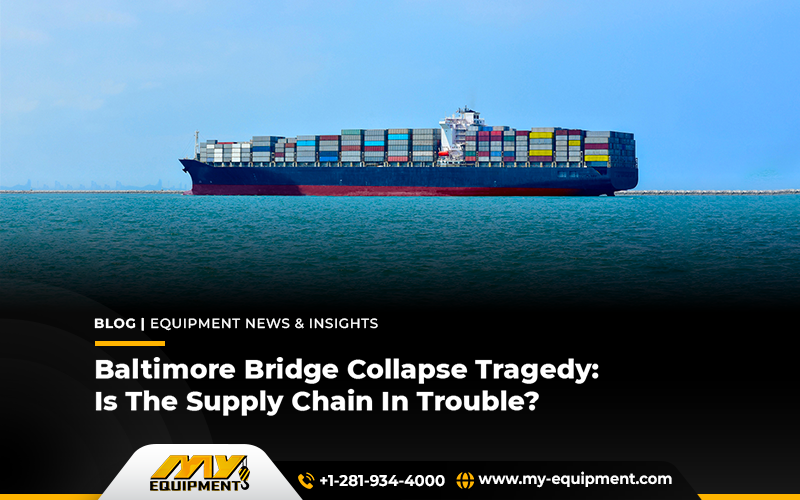Bridges and roads are the way to keep the trading and transportation flow at a regular pace in any region. However, there are some cities and regions in the world that are majorly dependent on the bridge structure to connect one part of the region to the other. In these regions, connecting infrastructures like bridges is extremely important for businesses and trading partners across the region.
But what would happen if the bridge collapsed or broke the linkage of the two sides?
Definitely, it will affect the businesses that are using the bridge to navigate throughout the region.
A similar incident was reported in Baltimore, Maryland where a major bridge collapsed leaving many business movements in distress. The business and supply chain of the Baltimore, Maryland, area has been rocked by the collapse of the Francis Scott Key Bridge. There have been terrible deaths in the incident, which was brought on by a massive container ship losing power and hitting the bridge. Several other major worries were also reported about the short- and long-term effects on businesses, customers, and the Port of Baltimore itself.
But, how will this whole incident affect the businesses in Baltimore and how long will it take to revive?
The intricate details of the incident and its consequences
When the cargo ship DALI and the Francis Scott Key Bridge collided in the early hours of March 26, the result was the collapse of the bridge and the deaths of multiple people. The Port of Baltimore, a vital hub for a variety of commodities including steel, aluminum, sugar, cars, agricultural equipment, and containers, suffered a stop in traffic and activities in the immediate aftermath. Ever stream Analytics’ worldwide director of intelligence, Mirko Woitzik, emphasizes the serious disruption this incident has caused to the supply chain along the U.S. East Coast.
Economic impact and disruption of the supply chain
The Port of Baltimore, which is one of the top 10 ports in the United States based on cargo value, handles between 30 and 40 container ships per week, loading and unloading more than 21,000 TEUs (containers). This port and the bridge have also been used to transport heavy equipment like a used track excavator or many other medical and agricultural equipment.
Unfortunately, these ships now have to detour to neighboring ports like Philadelphia and Norfolk due to the bridge collapse making the port inaccessible, which causes traffic jams, delays, and operational difficulties. This disruption poses a significant financial risk in addition to a logistical one. Container xChange highlights that the port supports approximately 15,000 direct jobs and an additional 139,000 occupations indirectly related to port operations, contributing nearly $3.3 billion in total personal income. As a result, the port’s closure could result in enormous economic losses. Beyond the port, businesses, consumers, and the whole economy are all impacted.
Consequences for companies and customers
The incident is indeed devastating and has left an impact of the grieve on the Baltimore people. However, the consequences have not only impacted the big companies but the customers and the dealers as well.
Increased Transportation expenses
When businesses are forced to look for alternate routes, transportation expenses rise. This might therefore result in increased product pricing, which would have an impact on both consumers and businesses.
Job Losses and Reduced Business Activity
The region’s economic growth may slow down as a result of the supply chain interruption, which may also result in job losses and decreased business activity.
Effect on Timely Deliveries
Goods that depend on timely delivery, like perishables or supplies that must be delivered by a certain time, may experience delays and quality problems that affect both consumers and businesses.
The significance of resilience and risk management
This situation highlights the importance of strong risk management, resilience, and backup plans in supply chain operations while the sector works through it. To lessen the effects of unexpected incidents like the bridge collapse, Christian Roeloffs, CEO of Container xChange, emphasizes the significance of real-time tracking, diverse route choices, and adaptable methods. This incident is a lesson for the dealers working in these regions. They are now obliged to plan their deliveries considering these types of unexpected events. This way, the panic and the damage could be lessened.
What to look ahead?
Rebuilding the bridge, resuming supply chain activities, and lessening the financial impact will be the main priorities in the upcoming months. Although the bridge reconstruction is not easy. It will require a heavy amount of capital and massive bridge construction equipment to rebuild the broken parts. This will ultimately take a lot of time.
It will be essential for businesses, government organizations, and other stakeholders to work together to ensure a speedy recovery and increase the region’s resilience against future disruptions.
A quick wrap-up
The collapse of the Baltimore Bridge has not only stopped the movement of supplies but also brought attention to the infrastructure’s vulnerability and the necessity of proactive risk management in supply chain activities. Resilience, recovery, and creating a more resilient and flexible supply chain ecosystem continue to be the major priorities as communities and businesses adjust to these difficulties.


 1400 Broadfield Blvd, Houston, TX 77084,
USA.
1400 Broadfield Blvd, Houston, TX 77084,
USA.